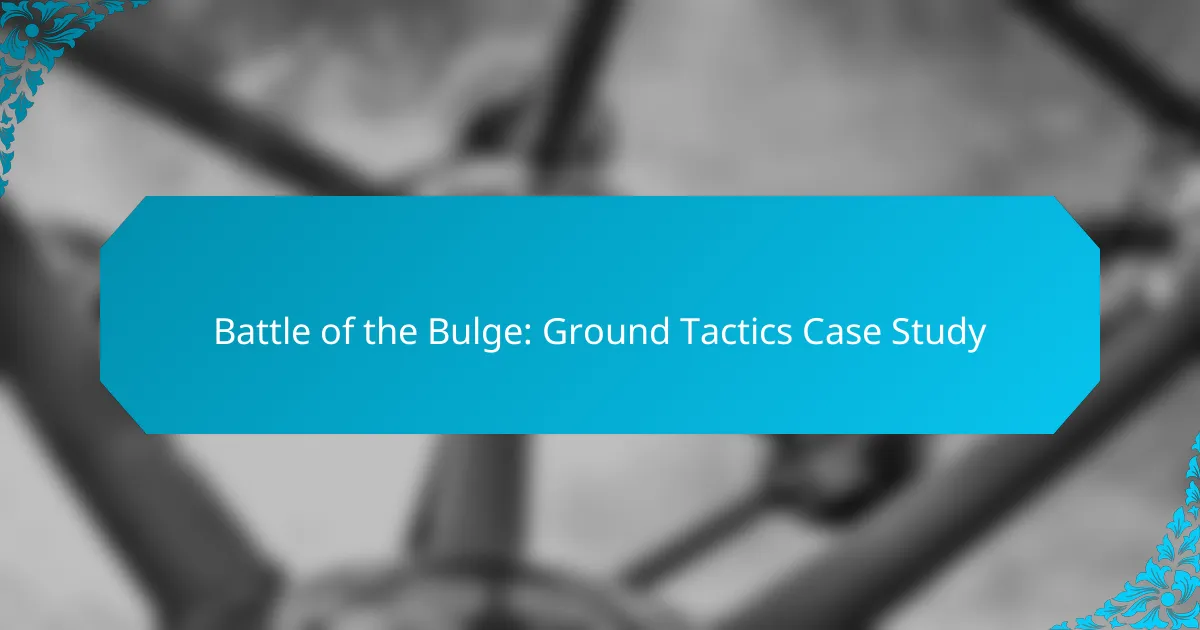Blitzkrieg tactics emphasize swift, coordinated assaults designed to quickly overwhelm adversaries. By utilizing strategies such as encirclement and combined arms operations, these tactics enable rapid movement and exploitation of enemy weaknesses. The successful implementation of Blitzkrieg has historically led to significant territorial gains and rapid victories, particularly for Germany during the early phases of World War II.

What Are the Key Blitzkrieg Tactics?
Blitzkrieg tactics focus on rapid, coordinated assaults that aim to overwhelm the enemy quickly. Key tactics include encirclement, shock and awe, rapid movement, combined arms operations, and exploitation of weaknesses.
Encirclement
Encirclement involves surrounding enemy forces to cut off their supply lines and escape routes. This tactic creates a situation where the enemy is isolated, leading to their eventual surrender or destruction. Successful encirclement requires precise coordination and timing among advancing units.
For example, during World War II, German forces effectively encircled Allied troops at Dunkirk, forcing a retreat under dire conditions. To implement this tactic, ensure your forces are well-positioned and communicate effectively to close the encirclement swiftly.
Shock and Awe
Shock and awe is a strategy designed to intimidate and demoralize the enemy through overwhelming force and rapid strikes. This approach relies on the element of surprise, using airpower and artillery to create chaos before ground troops advance. The goal is to disrupt command structures and instill fear.
In practice, this can involve a concentrated bombardment followed by immediate ground assaults. Ensure your forces are prepared to exploit the confusion created by initial strikes, as timing is crucial for maintaining momentum.
Rapid Movement
Rapid movement emphasizes speed and agility in troop deployment to outpace the enemy’s response. This tactic allows forces to penetrate deep into enemy territory before they can regroup. It requires well-trained units and effective logistics to sustain momentum.
For instance, during the early stages of World War II, the German Wehrmacht utilized rapid movement to quickly conquer Poland and France. To achieve rapid movement, prioritize mobility in your planning and maintain a flexible command structure to adapt to changing conditions.
Combined Arms Operations
Combined arms operations integrate different military branches—infantry, armor, and air support—to create a cohesive fighting force. This approach maximizes the strengths of each unit type while compensating for their weaknesses. Coordination among these branches is essential for success.
For example, using tanks to breach defenses while infantry secures the area can lead to effective breakthroughs. Ensure that communication systems are in place to facilitate real-time coordination among units during operations.
Exploitation of Weaknesses
Exploitation of weaknesses involves identifying and targeting vulnerabilities in the enemy’s defenses or strategy. This tactic requires intelligence gathering and analysis to determine where the enemy is most susceptible to attack. Once identified, forces can concentrate their efforts on these weak points.
For instance, if an enemy has a poorly defended flank, directing forces to exploit that gap can lead to significant advantages. Regularly assess enemy positions and adapt your strategy to capitalize on any discovered weaknesses.

How to Implement Blitzkrieg Tactics Effectively?
To implement Blitzkrieg tactics effectively, focus on rapid movement, surprise, and overwhelming force. This requires thorough preparation, seamless coordination among units, and the strategic use of technology.
Training and Preparation
Effective Blitzkrieg tactics hinge on rigorous training and preparation. Units must practice rapid maneuvers and develop a deep understanding of their roles within the larger strategy. Regular drills that simulate real combat scenarios can enhance readiness.
Additionally, soldiers should be trained in various combat situations to ensure adaptability. This includes both offensive and defensive operations, as well as urban and rural engagements.
Coordination Among Units
Coordination among units is crucial for the success of Blitzkrieg tactics. Clear communication channels must be established to ensure that all units can respond quickly to changing battlefield conditions. This often involves using radio communications and command structures that facilitate rapid decision-making.
Joint exercises can help foster teamwork and understanding between different branches of the military. Ensuring that infantry, armor, and air support can operate in unison is key to maintaining momentum during an offensive.
Utilizing Technology
Technology plays a vital role in implementing Blitzkrieg tactics. Modern warfare relies on advanced weaponry, reconnaissance drones, and real-time data analysis to enhance operational effectiveness. Utilizing these technologies allows for better situational awareness and faster response times.
For example, employing armored vehicles equipped with communication systems can significantly improve unit coordination and speed. Investing in technology that supports rapid movement and information sharing is essential for success.
Adapting to Terrain
Adapting to terrain is a fundamental aspect of effective Blitzkrieg tactics. Understanding the physical landscape can dictate movement strategies and operational planning. Units must be trained to navigate various terrains, from urban environments to open fields.
Terrain analysis should be conducted prior to operations to identify potential choke points and advantageous positions. This preparation allows forces to exploit the terrain to their advantage, enhancing the effectiveness of rapid assaults.

What Are the Historical Outcomes of Blitzkrieg Tactics?
Blitzkrieg tactics led to rapid victories for Germany in the early stages of World War II, fundamentally changing military engagements. The combination of speed, surprise, and coordinated attacks resulted in significant territorial gains and the quick defeat of opponents.
Success in Early WWII
Blitzkrieg tactics were notably successful during the invasions of Poland and France in 1939 and 1940. The strategy relied on fast-moving units, including tanks and aircraft, to disrupt enemy lines and encircle forces, leading to quick capitulations. For example, the fall of France took just six weeks, showcasing the effectiveness of this approach.
This method of warfare emphasized mobility and coordination, allowing German forces to exploit weaknesses in enemy defenses before they could effectively respond. The psychological impact of such swift victories also demoralized opposing troops and governments.
Impact on Military Strategy
The success of Blitzkrieg tactics prompted a reevaluation of military strategies worldwide. Nations recognized the importance of speed and flexibility in modern warfare, leading to the development of similar doctrines that emphasized rapid maneuvering and combined arms operations. This shift influenced military training and planning for decades.
Many countries began investing in mechanized units and air support, understanding that traditional static defenses were inadequate against fast-moving assaults. The legacy of Blitzkrieg can be seen in various military doctrines adopted during the Cold War and beyond.
Lessons Learned
One key lesson from Blitzkrieg is the importance of coordination among different military branches. Successful implementation requires seamless communication and joint operations between ground forces, air support, and logistics. This integrated approach can significantly enhance operational effectiveness.
Another lesson is the need for adaptability in strategy. While Blitzkrieg was effective in specific contexts, its reliance on speed and surprise means it may not be suitable for all situations. Military planners must assess the unique characteristics of each conflict to determine the best approach.

What Are the Prerequisites for Successful Blitzkrieg Implementation?
Successful implementation of Blitzkrieg tactics requires a combination of strong leadership, effective resource allocation, and thorough intelligence gathering. These elements work together to create a rapid and coordinated military strategy that can overwhelm opponents.
Strong Leadership
Strong leadership is crucial for the effective execution of Blitzkrieg tactics. Commanders must make quick decisions and maintain clear communication across units to ensure that all forces are synchronized in their movements. This requires leaders who are not only decisive but also capable of inspiring and motivating their troops.
Effective leaders should also be adaptable, able to respond to changing battlefield conditions and adjust strategies as necessary. Training and experience in rapid decision-making can significantly enhance a leader’s ability to implement Blitzkrieg successfully.
Resource Allocation
Resource allocation involves ensuring that troops, equipment, and supplies are positioned and utilized effectively. Blitzkrieg relies on speed and surprise, so resources must be distributed in a way that allows for rapid advances and sustained pressure on the enemy. This often means prioritizing mobility and firepower over static defenses.
Units should be equipped with modern technology and sufficient supplies to maintain momentum. Regular assessments of resource availability and logistical support are essential to avoid bottlenecks that could hinder operations.
Intelligence Gathering
Intelligence gathering is vital for successful Blitzkrieg tactics, as it provides commanders with the information needed to exploit enemy weaknesses. Accurate and timely intelligence allows for informed decision-making and helps identify the best opportunities for rapid attacks.
Utilizing reconnaissance units, aerial surveillance, and signals intelligence can enhance situational awareness. Establishing a robust system for collecting and analyzing intelligence ensures that leaders have the necessary insights to act swiftly and effectively in combat scenarios.

How Does Blitzkrieg Compare to Other Military Strategies?
Blitzkrieg, or “lightning war,” emphasizes rapid movement and surprise to achieve quick victories, contrasting sharply with more static military strategies. Unlike traditional approaches, it focuses on speed, coordination, and the use of combined arms to disrupt enemy defenses effectively.
Differences from Trench Warfare
Trench warfare is characterized by prolonged stalemates and static front lines, where soldiers dig in for defense. In contrast, Blitzkrieg relies on mobility and rapid advances, using mechanized infantry and armored units to penetrate enemy lines and encircle forces. This dynamic approach aims to achieve decisive victories in a matter of days or weeks, rather than the years often seen in trench warfare.
The tactics of Blitzkrieg involve coordinated assaults that combine air power, artillery, and ground troops, allowing for swift breakthroughs. This method contrasts sharply with the attritional nature of trench warfare, where both sides suffer heavy losses without significant territorial gains. The psychological impact of Blitzkrieg tactics can demoralize the enemy, leading to quicker surrenders.
Advantages Over Attrition Warfare
Blitzkrieg offers several advantages over attrition warfare, primarily through its focus on speed and surprise. While attrition warfare seeks to wear down the enemy through sustained engagement, Blitzkrieg aims to achieve rapid victories with minimal casualties. This strategy can conserve resources and maintain troop morale, as victories are achieved quickly.
Another key advantage is the ability to disrupt enemy supply lines and command structures. By striking swiftly and unexpectedly, Blitzkrieg can create chaos within enemy ranks, making it difficult for them to mount an effective defense. This can lead to significant territorial gains with fewer resources expended compared to prolonged engagements typical of attrition warfare.
To implement Blitzkrieg effectively, commanders should prioritize intelligence and reconnaissance to identify weak points in enemy defenses. Additionally, maintaining flexibility and rapid communication among units is crucial for adapting to changing battlefield conditions. Avoiding overextension and ensuring adequate supply lines are essential to sustain momentum and capitalize on early successes.

What Are the Modern Applications of Blitzkrieg Tactics?
Modern applications of Blitzkrieg tactics focus on rapid, coordinated strikes to achieve swift victories in various fields, including military operations, business strategies, and cybersecurity. These tactics emphasize speed, surprise, and the effective use of technology to outmaneuver opponents.
Military Operations
In contemporary military contexts, Blitzkrieg tactics are adapted to leverage advanced technology and intelligence. Forces utilize drones, cyber warfare, and rapid troop movements to disrupt enemy operations quickly. The emphasis is on achieving decisive victories before the opponent can effectively respond.
For example, during recent conflicts, nations have employed rapid assaults using air and ground forces to capture strategic locations, minimizing prolonged engagements. This approach often leads to reduced casualties and resource expenditure.
Business Strategies
In the business realm, companies apply Blitzkrieg principles to outpace competitors by launching innovative products or services quickly. This involves rapid market entry, aggressive marketing, and leveraging digital platforms to create a strong initial impact.
Startups, for instance, often use these tactics to disrupt established markets by offering unique solutions that attract customers rapidly. The key is to maintain agility and adapt quickly to market feedback to sustain momentum.
Cybersecurity
Blitzkrieg tactics are increasingly relevant in cybersecurity, where rapid response to threats is crucial. Organizations implement swift detection and response systems to counteract cyberattacks, aiming to neutralize threats before they can escalate.
Effective cybersecurity strategies often include automated monitoring tools and incident response teams that can act within minutes. This proactive approach helps mitigate damage and protect sensitive data from breaches.



